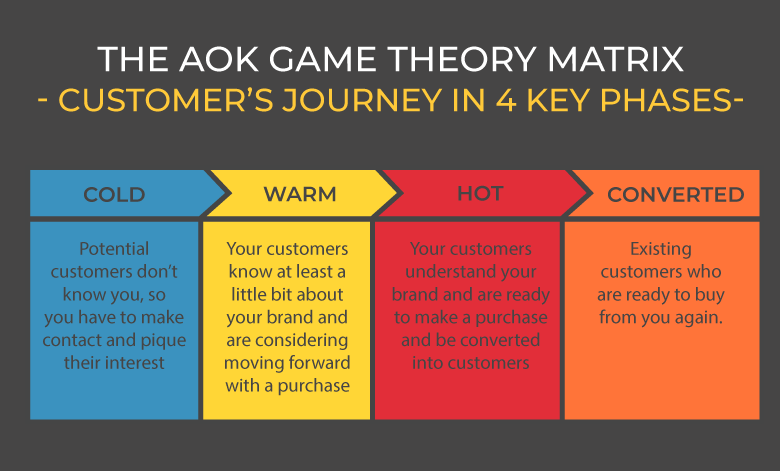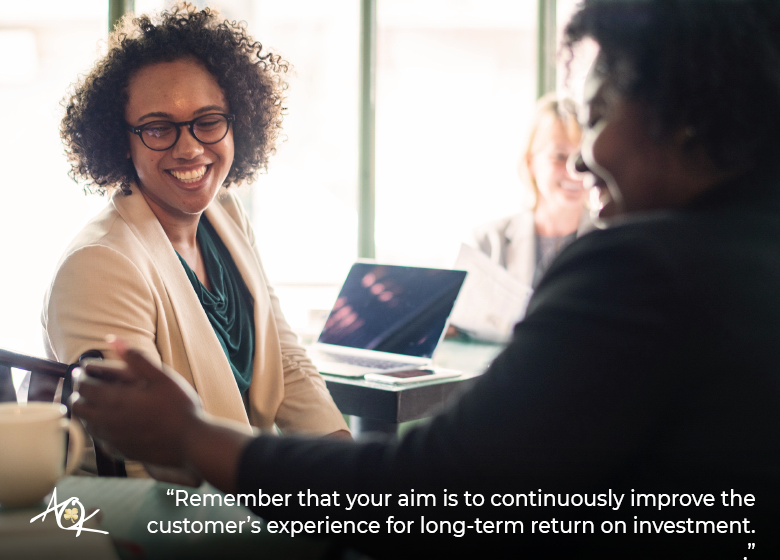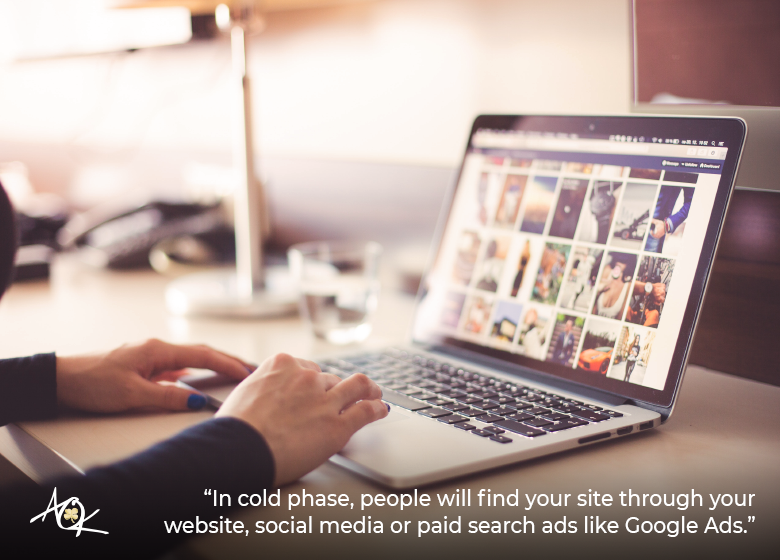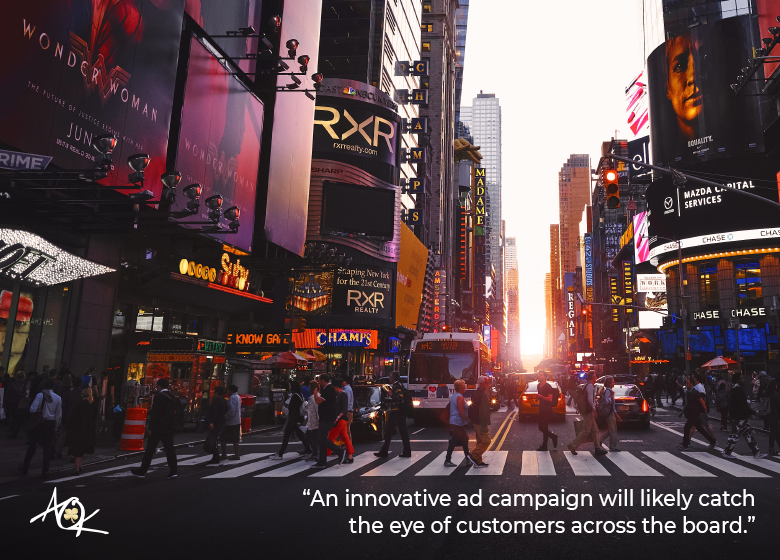The AOK Game Theory matrix describes the customer journey (or sales funnel) in terms of 4 key phases:
- Cold: Potential customers don’t know you, so you have to make contact and pique their interest.
- Warm: Your customers know at least a little bit about your brand and are considering moving forward with a purchase.
- Hot: Your customers understand your brand and are ready to make a purchase and be converted into customers.
- Converted: Existing customers who are ready to buy from you again.
While we’ve listed each of these phases as separate columns on the matrix, it’s important to consider that through each step, it’s vital also to be thinking ahead to the next phase of their journey. This is especially true as both decisions and purchases can be made extremely quickly in the digital sphere.
It’s also essential to bear in mind that the phase is not always going to be linear – sometimes you’ll have cold leads that move to the hot phase directly, and sometimes you’ll have people hovering somewhere in-between.
You’ll also want to understand appropriate key performance measures to analyze traffic patterns and monitor gaps and changes in each phase and how those relate to your traffic flows in the next phase.
Remember that your aim is not to “make a sale,” but to continuously be improving the customer’s experience for long-term return on investment.
How to Approach Cold Traffic (so you don’t scare them off…)
In the world of digital marketing, your cold traffic is basically anyone who could need your service, so if you are offering something that everyone needs and you ship worldwide, in effect this could mean that anyone with a computer or mobile device is your possible audience.
Most likely you will already have a little bit of information about your intended market given the nature of your product and any market research you’ve already done. But in practice, it’s a good idea to assume that you’re “coming out of nowhere” — you make the effort to stand out to those who aren’t even looking to buy.
These are people that will find your site through your website, through social media or possibly paid search ads like Google Ads.
The cold-to-warm phase is not about converting, remember: here, you are making an impression. You’ll want to focus on creating some awesome social content (video is great), designing an eye-catching landing page, and developing a following and a mail list.
Your key goals with cold traffic are:
- Introduce yourself
- Share your brand story
- Offer some information about your products
- Start the process of building a relationship
- Show your authority in your field or industry
- Build trust
As you engage with your customers on your site, you’ll want to be tracking and learning as much as you can about them to direct them appropriately to the next phase of their journey.
One super simple way to do this if you have a Facebook group is to design a poll. And Google Analytics has plenty of metrics to draw from – but be sure to choose the right ones.
Heating Things Up (cue the slow jam…)
Keeping your customers “warm” enough to not only make a purchase but also stick around for a while is really about relationship-building. Just like with any relationship, a healthy one depends on understanding what they want.
In order to gain an understanding of their motivations, you‘ll want to be tracking their behaviour and engaging consistently in order to ensure that you are ready and willing to assist them through their journey. This will likely involve some trial and error as you continue to reach out to them with various offers and see where they “bite.”
Here are some ideas for offerings you can use (through the cold and warm phases) to engage them and make them interested enough to purchase:
- Informative blog posts that offer “free” value
- Lead magnets
- Creative demo videos (YouTube)
- Podcasts
- Webinars
- Surveys
As you address your warm traffic, you’ll know that they already know something about you and find your product or service interesting enough to be following you on Facebook, for instance. At the warm phase, they are maybe looking to buy, but you still have some convincing to do.
The main thing that you want to do here is to get them to trust you enough that they will invest in what you have to offer. You can do this by continuing to offer free or low-priced products via email and social media.
Remember that this isn’t a phase where you should ask for a big purchase – instead, you’ll want to offer them something of value so that they understand it’s a reciprocal game.
This is also an excellent opportunity to do something different so that you create a lasting impression. Adding a little humor, partnering with a relevant celebrity or business to create an innovative product, or integrating multiple marketing strategies for your next campaign can all work wonders for catching attention in the digital sphere.
How to Measure Success
Choosing the right Key Performance Indicators (KPIs) will be an essential part of understanding each phase and creating an outstanding customer journey.
Cold Traffic
Because your cold traffic will be centered on social media and ads, you’ll be focused on engagement actions, not actual sales. Examples include:
- Indexed Brand Awareness
- Percent of new visits
- Comments, likes, and shares
Warm Traffic
In the warm traffic phase, you’ll be focused mainly on things like ads, email, SEO, and video. Thus, your KPIs will be centered more around your owned audience. You’ll want to assess things like:
- Click through rates for emails
- Page depth
- Percent of assisted conversions
Hot Traffic (ABC – always be closing… hot traffic)
Your hot traffic is really where you’re about to make a sale, or it may also be made up of people who have previously made a purchase and are ready to buy again. They understand your brand, products, and service and already have a feeling of trust built up.
Here you can focus on metrics more closely related to the decision point of the actual sale. Your goals here should be based on upselling and re-engaging with those who may have been previous customers but have not made a purchase in a while.
Examples of KPIs to track include:
- Conversion rate
- Return visits
- Profit
- Check-out abandonment rate
Converted Traffic (show them some love!)
At the conversion phase, you’ll be selling to repeat customers and focusing on brand loyalty. In essence, you will be looking at all kinds of advertising, as well as email and social.
KPIs to consider include:
- Recommendations
- Repeat purchases
- Customer lifetime value
- Monthly active users
Pay Special Attention to your Loyal Customers (just ask Starbucks!)
Many companies make the mistake of putting all of their resources into advertising primarily to cold traffic just to bring in customers when what you need to be focusing on just as much is how to keep the customers you have.
Of course, this will depend on whether you have the type of product that requires repeat purchases – if this is not the case; you’ll need to cross-sell and offer complementary products that fit with your brand. Because customer acquisition is expensive, offering complimentary products and opportunities to purchase
For instance, people probably aren’t likely to buy more than one new BMW in the course of a few years, however, if you upsell them to the service center, that’s your continued ROI over time.
A simple stamp card at a coffee (buy 10, get one free) is another example of an effective way to build brand loyalty.
Key Platforms (the Google, the bad, and the ugly…)
Marketing platforms that tend to be effective in each phase of the journey are display and pay-per-click ads.
Email can also be an extremely and inexpensive way to nurture leads during the warm, hot and converted phase as it has the potential to be quite versatile. Here are a few ideas about how to use email lists:
- You can easily automate your email lists in segments
- You can use your unsubscribe list for re-targeting (e.g., Facebook ads)
- You can use email lists to build brand awareness and engage
- You can use email lists to send value-based content such as webinars to your loyal customers
Surviving in the Digital Sphere
The customer journey from initial awareness the point of purchase is tricky for any marketer and in the world of online marketing, getting to the conversion phase can be more challenging than ever. We’re in a global marketplace – how can businesses possibly expect to keep up?
Keeping on top of trends will be key to your success.
There are many ways to effectively remove (or lessen) this barrier that is the screen and encourage your audience to be more engaged. Consider incorporating technology such as chatbots, virtual reality, and professional level video to encourage a more personal experience.
You’ll also want to stay on top of the latest trends and approaches. Micro-moment marketing, for instance, is based on the fact that consumer behaviour is changing to a more moment-to-moment, mobile-based system.
Today, consumers can essentially get the “best” of anything they want in a matter of minutes. And influencer marketing – using well-known social media personalities and celebrities – remains one of the best ways to get the word out about your brand or product.
Creating an Excellent Customer Experience
If there’s one thing all businesses have in common, it’s that they always want more customers. But converting customers is really only a fraction of what’s behind a truly remarkable marketing strategy.
Every business needs to consider how each phase of the customer journey affects the next, and even how different marketing strategies can work to attract and retain customers across multiple segments.
Another thing to remember is that each phase isn’t really separate – we’re just sharing it this way to give you a clear idea of audience segmentation. While it’s true that cold leads can’t simultaneously be converted customers, for instance, an innovative ad campaign will likely catch the eye of customers across the board.
Finally, as you target your marketing activities and strategy towards each phase of the buyer journey, you’ll always want to also be thinking ahead to the next phase of their journey. For instance, how can you offer a warm lead now to encourage them to not just buy once, but stick around to purchase something else in the future?
Maintaining buyer interest, nurturing cold and warm leads, and keeping customers moving when they’re in the hot phase all depend on how you communicate your offerings and make them understand that the value exchange is truly reciprocal rather than one-sided.
About The Author
Dave Burnett
I help people make more money online.
Over the years I’ve had lots of fun working with thousands of brands and helping them distribute millions of promotional products and implement multinational rewards and incentive programs.
Now I’m helping great marketers turn their products and services into sustainable online businesses.
How can I help you?












